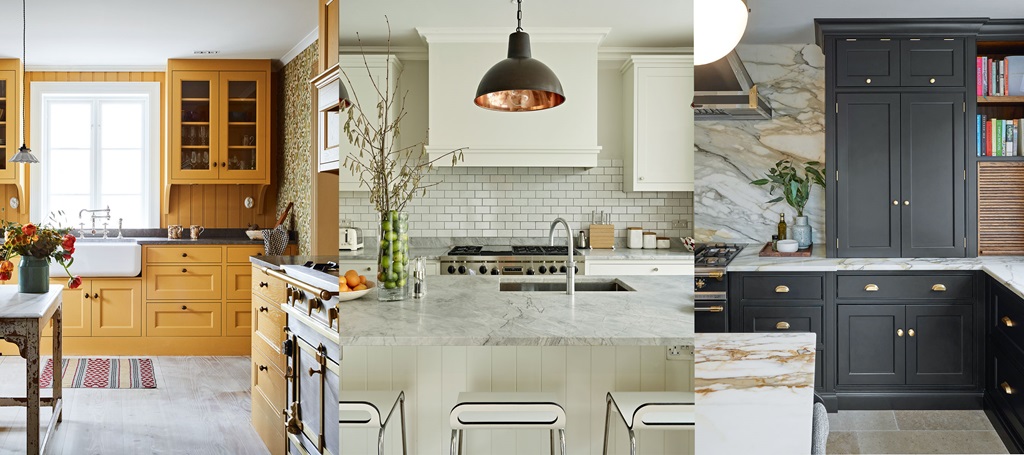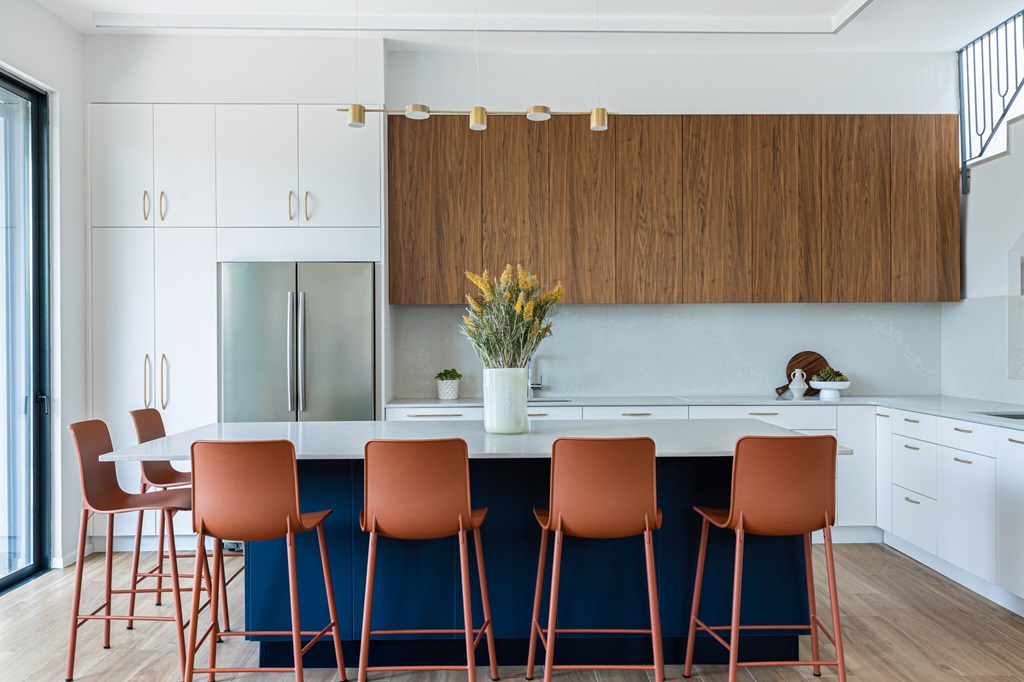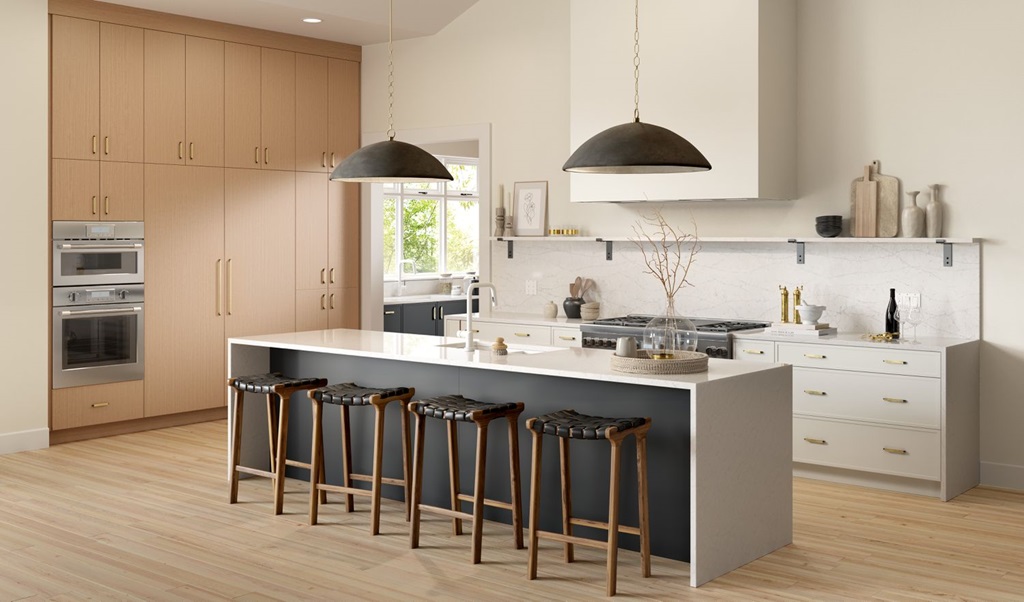
24 Dec How to Combine Modern Kitchen Cabinets Colors
Updating your kitchen with a fresh coat of paint or new cabinetry can instantly modernize the space. If you’re looking to revamp your kitchen, a simple yet effective way to do so is by giving it a fresh coat of paint or new cabinetry. While the classic white and gray color schemes continue to be a popular choice, it’s important not to shy away from incorporating a bit of color to add some vibrancy to your space. The trick is to strike a perfect balance between the colors you choose, so that they work together seamlessly to create a cohesive look that’s both modern and inviting. Follow these expert guidelines on modern kitchen cabinets in kitchen designs.
Use a Main Color for Modern Kitchen Cabinets
When combining colors, choose one dominating shade as an anchor. Keeping one color consistent throughout a majority of cabinets creates flow. For example, painting the lower and upper cabinets a crisp white while using a bold raspberry hue just on the island allows the red to pop as an accent. Alternatively, stick to a dark espresso finish on the base cabinets and experiment with lively green or navy uppers.
Contrast Within Color Families
Selecting tones from the same color family ensures they will work seamlessly together. Mixing both cool and warm variations of analogous shades (colors next to each other on the color wheel) is an easy way to add multi-dimensional interest. For instance, pair icy blue cabinets with serene sage green uppers or vibrant orange lowers with subdued peach uppers. The colors are similar enough in tone but offer subtle contrast.
Infuse Metallics for Modern Drama
For contemporary edge, infuse metallics like brass, bronze and steel. This ties directly into the popular industrial design trend. Try brass hardware paired with smooth white or light gray cases for an elegant metallic moment. Or go bold with matte black lowers and polished copper uppers for striking visual impact. The sheen of metals plays beautifully off matte cabinet finishes.
Define Separate Spaces with Color

In large, open concept kitchens use color to define separate zones. For example, treat the kitchen as one space with all-white or all-black cases. Then mark the transition to dining area with an island or accent wall sporting bold navy blue cabinets. This clearly distinguishes unique areas while unifying the scheme through neutral bases.
Use Neutrals as a Bridge
When working with extremely vivid hues, employ neutral shades as a bridge. Bouncing from one intense color to another can feel jarring. Incorporate creamy whites, warm taupes or cool grays between the brighter colors. Think red cabinets next to neutral beiges next to emerald greens. This allows your eye to adjust in between the pops of color.
Highlight Display Areas
Use cabinet color to draw attention to open shelving units or glass door displays intended for showing off glassware, dishes or decorative items. For example, try a warm antique white finish on the surrounding cabinets and add a vibrant light turquoise to the open corner showcase. This treats the display area as a built-in accent piece.
Establish Balance
When mixing several cabinet colors, stick to the 60-30-10 rule. This means 60% is the dominant shade, then 30% as the secondary color and 10% reserved for the boldest accent tone. For instance, if you love blue and green, keep baby blue on 60% of cabinets, add pine green to 30% and punchy lime green on just 10%. This creates diversity while maintaining harmony.
Compare Undertones
Study undertones before matching colors. A cool undertone means the color leans blue/purple while warm has hints of yellow/red. Combining cool and warm undertones can look disjointed (think icy blue cabinets with fire engine red). Stick with all warm shades or all cool tones for a cohesive effect. Adding neutral white, black or wood tones bridges this gap nicely.
Incorporate Natural Wood Finishes
Don’t overlook natural wood finishes like oak, cherry and walnut to balance painted cabinets. Wood grain adds gorgeous, veining texture and effortlessly fits with both cool or warm shades. Try open-grained whitewashed oak kitchen cabinets paired with smooth robin’s egg blue cases. The wood warmth grounds the cooler tone.
Define Functional Spaces
Assign cabinet colors based on functional zones. Keep cleaning supply areas or food prep spaces neutral for straightforward utility. Then make dining zones or glassware displays more vibrant and fun with daring colors like citron, violet or coral. This strategy visually separates cabinet purposes while allowing personality in chosen spots.
Overlay Colors Onto Neutral Bases

When dealing with small or awkward kitchen layouts, stick to one neutral base color on all cabinets. Bright white, soft beige and warm walnut are safe bets. Then overlay a punch of color via interchangeable door fronts or hardware. This allows you to switch up shades seasonally without a major renovation investment. Simply repaint or replace door fronts to achieve a new look!
Now that you’re equipped with expert techniques for combining modern kitchen cabinet colors, it’s time to determine the perfect palette for your space! Feel free to blend, contrast and play with dazzling hues and textures. Just maintain the proper balance to avoid total chaos. With a few key guidelines, you can achieve stunning kitchen style.
In Conclusion
When designing modern kitchen cabinets, don’t limit yourself to all white or all wood toned cabinets. Take risks by combining colors, contrasts and textures throughout built-ins and storage zones. Anchoring with one dominant tone while weaving in accent colors prevents chaos. Just follow basic guidelines like comparing undertones, establishing proper balance and bridging brights with neutrals. Feel free to define specific areas through strategic color placement as well. From metallics to pastels, the options for blending contemporary cabinet colors are endless! Careful planning allows you to assemble your own customized, ultra-modern palette.
FAQs
Q: What are the 5 most popular modern kitchen cabinet colors?
A: The current top 5 trends include crisp or antique whites, cool grays, dramatic navy blues, natural light or medium wood grains and matte black for a sleek style statement.
Q: What color cabinets are in style for 2023?
A: Sustainably sourced wood finishes as well as warm camel, bronze and deeper jewel tone shades emerge as rising 2023 cabinet color developments, while mainstays like white, gray, black and navy blue endure. Unique metallics also offer contemporary flair.
Q: What colors look best with oak cabinets?
A: Lively citrus orange, mint or Kelly green, sky blue, buttery yellow, light peach, brick red and chocolate brown offer pleasing contrast against golden oak while still appearing cohesive. Avoid pairing oak wood finishes with cool grays or whites that can clash with the warm natural tones.
Q: What current color trends work for small kitchen spaces?
A: Illuminating mildly saturated shades that maximize light feel especially welcoming in tiny kitchens. Think warmer pastels like buttercream, sage or cornflower blue. Glossy finishes also reflect light nicely to make compact rooms feel more expansive.
Q: Can I mix cabinet wood stains and painted colors?
A: Absolutely! Blending natural wood stains with painted hues adds alluring depth while still balancing tones. Try open grain medium oak cabinets on bottom with milky white uppers. Or contrast espresso stained base cases with lively turquoise open shelving.



Sorry, the comment form is closed at this time.